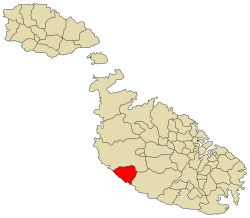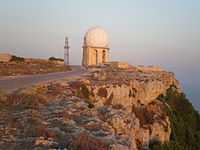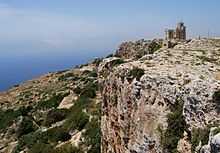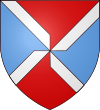Dingli
| Dingli (Kunsill Lokali ta' Ħad-Dingli - Dingli Local Council) Casal Dingli;[1] Ħal Tartarni [2] | |||
|---|---|---|---|
| Local council | |||
| Dingli | |||
 | |||
| |||
|
Motto: Non Segnis Quies Ruris (The Rural Silence is Not Laziness) (Is-Skiet tar-Raba Mhux Għażżien) | |||
 | |||
| Coordinates: 35°51′37″N 14°22′53″E / 35.86028°N 14.38139°ECoordinates: 35°51′37″N 14°22′53″E / 35.86028°N 14.38139°E | |||
| Country |
| ||
| Island | Malta | ||
| Borders | Rabat, Siġġiewi | ||
| Government | |||
| • Mayor | Ian Borg (PL) | ||
| Area | |||
| • Total | 5.7 km2 (2.2 sq mi) | ||
| Population (Nov 2005) | |||
| • Total | 3,347 | ||
| • Density | 590/km2 (1,500/sq mi) | ||
| Demonym | Dingli (m), Dinglija (f), Dinglin (pl) | ||
| Time zone | CET (UTC+1) | ||
| • Summer (DST) | CEST (UTC+2) | ||
| Postal code | DGL | ||
| Dialing code | 356 | ||
| Patron saint | The Assumption of Our Lady | ||
| Day of festa | First Sunday after 15 August | ||
| Website | Official website | ||
| Bus 52 from Valletta terminus | |||




Ħad-Dingli is a village on the west coast of Malta, with a population of 3,326 persons (Nov 2005), 13 kilometres (8 miles) from the capital Valletta and two kilometers (1.2 miles) from the nearest town, Rabat. The village lies on a plateau some 250 metres above sea level, which is one of the highest points of Malta. The area provides not only open sea views over the tiny, uninhabited isle of Filfla, but is also a good vantage point over Malta.
From the cliffs there are views inland of nearby Buskett Gardens and Verdala Palace.
Ħad-Dingli's History at a glance
Dingli is a small village at the extreme end of Malta, quite remote from the centre. The distance was felt even more up to forty years ago when public transport could only reach up to Rabat. To arrive at Dingli one had to make the journey either on foot or by means of a rough ride on a farmer's cart. Up to sixty years ago there was no telephone service for private homes. It was then considered difficult to travel to other localities of Malta.
Around the beginning of civilization in Malta, notwithstanding the extreme poverty which depressed the whole island, Dingli had the benefit of being situated near Rabat. In fact, from olden times up to the Middle Ages, the centre of Malta was not Valletta but first Rabat and then Mdina. The present capital city was built from scratch only during the second half of the sixteenth century.
The Popular Council which governed the Island had its headquarters in Rabat. Dingli for many centuries was part and parcel of the civil administration of both Rabat and Mdina. Dingli had the same representatives, the same mayor and the same doctor. Only with great difficulty, could one find a priest who was willing to accept to live at Dingli or at Ħal Tartarni – a place which historical sources have always confirmed the intimate connection with Dingli.
But, when the Maltese Church initiated the process of dividing the Island into parishes, not only in the cities but also in the rural zones, the small locality of Ħal Tartarni could not be overlooked and someone had to be found to shoulder the responsibility of the spiritual aspect of the people, thus making this small village one of the first parishes ever in Malta. Ħal Tartarni, which was the only inhabited area, was in the vicinity of the small forest created by Grand Master Verdala towards the end of the sixteenth century. There was a very small church dedicated to Saint Domenica, which today does not exist any longer. Just before the year 1436, this church was elevated to the dignity of a parish.
And then, after various ups and downs, which from a historical point of view cannot be clearly verified, all the population moved towards that zone called Dingli. This can be assumed to have resulted from the fact that the noble family Inguanez possessed vast territories of land in that zone. The farmers employed to work the fields of the Inguanez family found it convenient to go to Dingli, thus abandoning completely Tartarni. This period can be said to represent the origin of this delicious village, noted for its pure and uncontaminated air.
The village existed and has been populated since remote times. Archaeologists conclude that in prehistoric times there were probably certain quarries from where stone could be hewn to construct rural abodes in various parts of the island.
In the times of the Phoenicians and the Carthaginians, graves were dug out of the rocks, and there is evidence of cremation. According to the custom of those times, before burial, wicks and various articles of earthenware and ornamental goods were placed inside the grave. From what was found, the objects certainly go back to the Carthaginian period. These can be said to go back to almost 2800 years ago. The Phoenician and Carthaginian tombs were also used by the Romans, who occupied the islands from 218 BC. At Għajn Handful, baths, swimming pools and some instruments of the Roman period were discovered. Even at the locality known as Ta’ Baldu, an area lying not far away from Triq Misraħ Suffara (Street), is rightly known for its Roman baths hewn inside caves.
The scarce historical information available about Ħal Tartarni gives some ray of light on the periods when we were under the Norman, Byzantine, Angevine and Aragonese rule. In those times, the Popular Council, with its offices at Rabat, had the full authority to govern over both Dingli and Ħal-Tartarni. Justice was meted out by Capitano della Verga. At the beginning of the reign of the Knights of St John, the population of these villages did not exceed three hundred inhabitants. The name of ‘Dingli’ was probably derived from the surname of some Maltese families who owned the land in this area.
Dingli is a locality near the sea and is full of cultivated fields, but at the same time stands imposingly very high above the sea. The cliffs reach a height of around 253 metres – the highest place in Malta. Thus the inhabitants do not earn their living by going fishing, but by assiduously tilling their fields. Even if they never became very rich, at least they could earn their living by means of husbandry and also from the produce of the fields. This was also an advantage during the second world war.
The Dingli Cliffs, in harder times than at present, were also sometimes beneficial. Centurys ago, Malta was frequently devastated by sea pirates, but Dingli was safe from attacks coming off the sea. As a matter of fact, in the great siege of 1565, landing was affected at Marsaxlokk and in Marsamxett.
This was only just a glance at Dingli of the past centuries. The inhabitants at that time struggled to survive in a very difficult environment. The sole pride that distinguished the inhabitants of Dingli was their devotion to the parish church dedicated to the Assumption of the Holy Virgin. But the dignity of the recognition of the Parish was suppressed several times. Afterwards, in 1678, the village had the satisfaction of having an established Parish Church with its own Parish Priest, and from then better times were in the offing.
Dingli is now a picturesque village looking towards the future with confidence. There is now a sense of well-being, which could not be envisaged in the not too-distant past. The population has increased in number fifteenfold since centuries ago. Statistics reveal that a century ago, it was difficult to send children to school. The boys used to work in the fields. The girls, from a tender age, helped in the domestic work. On the contrary, nowadays, everyone goes to school, not only to the primary but also to the secondary schools. There are also others who continue their studies at the Malta University from where the best even attain a doctorate in their field of study.
Dingli is the birthplace of many eminent personalities who have honoured not only the village but also the entire Maltese Islands. In the literary field, one can mention renowned authors like folklore pioneer Dun Xand Cortis and playwright Francis Ebejer. The Catholic Church was blessed with the Dominican friar Walter Ebejer, who was ordained Bishop of a diocese in Brazil. In the political field, Notary Guze’ Abela was an outstanding minister of finance, who was widely respected for his sound judgment and above all for his integrity.
Clubs and Organisations in Ħad-Dingli
- Dingli Youth Local Council
- Dingli FCCS Soc. Ltd.
- Ghaqda Muzikali Sta. Marija (Band Club)
- Dingli Swallows Football Club
- Dingli Swallows Supporters' Club
- Dingli Talent Society
- Dingli Labour Youth Forum
- Dingli Youth Network
- Dingli Scout Group
- Girl Guides (19th Dingli) [Dolphins, Brownies,Guides,Rangers,young leaders and Leaders]
- Malta Labour Party
- Nationalist Party
- Salesian Oratory
- Christian Doctrine Society
- Legion of Mary
- St. Mary's Parish Church, Triq il-Parroċċa (Parish Street)
- Dingli Local Council, Daħla tas-Sienja (Sienja Lane)
- Dingli Youth Local Council, Daħla tas-Sienja (Sienja Lane)
- Dingli Police Station, Triq il-Kbira (Main Street)
- Dingli Band Club, Misraħ Frenċ Abela (Frenċ Abela Square)
- Dingli Swallows F.C. Club, Triq il-Parroċċa (Parish Street)
- Dingli Swallows F.C. Youth Nursery, Triq il-Parrocca (Parish Street)
- Dingli Malta Labour Party Club, Triq il-Parroċċa (Parish Street)
- Dingli Partit Nazzjonalista Club, Triq il-Kbira (Main Street)
- Dingli Sub-Post Office, Misraħ Frenċ Abela (Frenċ Abela Square)
- Dingli Area Library, Triq il-Kbira (Main Street)
- Dingli Health Centre, Triq Ġużè Ellul Mercer (G. Ellul Mercer Street)
- Parish Pastoral Council, Centru Parrokkjali Familja Mqaddsa, Triq San Pawl (St Paul Street)
- Klabb Nisa Dingli, Centru Parrokkjali Familja Mqaddsa, Triq San Pawl (St Paul Street)
- Grupp Familji Nsara Sagra Familja (GFN), Centru Parrokkjali Familja Mqaddsa, Triq San Pawl (St Paul Street)
- Kor Parrokkjali Regina Coeli, Centru Parrokkjali Familja Mqaddsa, Triq San Pawl (St Paul Street)
The Dingli Local Council currently comprises the following members:
- Venera Micallef (PL)
- Mark Vincent Abdilla (PL)
- David Vassallo (PN)
- Sandro Azzopardi (PL)
- John Camilleri (PL)
Dingli Youth Local Council
The Dingli Youth Local Council was established on 12 November 2011. Meetings are held every week and everybody can attend. The official site of the Youth Local Council is : www.facebook.com/zghazaghdinglin.
Various activities will be organized throughout the year.The current members are:
- Maria Bella Abela - Mayor
- Amy Tanti - PRO
- Rachela Saliba - PRO
- Sara Abdilla - Treasurer
- Maxine Farrugia - Secretary
- Justine Falzon - Youth Worker
For more information please contact the members on Facebook.
Interesting Places in Ħad-Dingli
- St. Mary's Parish Church (in Parish Street)
- Dingli Band Club premises
- St. Domenica Chapel situated in Triq il-Għajn (at Rill Street)
- Dingli Cemetery (at Magdalena Street)
- St. Magdalena Chapel (at Dingli Cliffs)
- Dingli Cliffs
- Savio College (at Buskett Road)
Village Core
- Triq il-Parroċċa (Parish Street)
- Triq San Rokku (St. Roque Street)
- Misraħ Ġużè Abela (G. Abela Square)
- Triq Għar Bittija (Għar Bittija Road)
- Triq il-Knisja (Church Street)
- Triq id-Dejqa (Strait Street)
- Triq San Pawl (St. Paul Street)
- Triq il-Kbira (Main Street)
- Misraħ Frenċ Abela (F. Abela Square)
- Triq l-Irdum (Cliff Street)
Zones in Ħad-Dingli
- Dingli Cliffs (Rdum ta' Ħad-Dingli)
- Ġnien Ġewwieri
- Għar il-Kbir
- Ħal Tartarni (Ħal Tartarni Town)
- Id-Dahar (The Back)
- Il-Ħofra
- Il-Kunfettier
- Il-Qaws (The Bow)
- Il-Qbiela
- It-Turretta
- Misraħ Suffara
- Rdum Dikkiena
- Rdum Madliena
- Ta' Cassia
- Faqqanija
- Ta' Għamajra
- Ta' Sabbat, limits of Buskett
- Ta' Xuxa (Hair's Village)
- Ta' Zekzek
- Ta' l-Imgħajlaq
- Tal-Ħawli
- Il-Ħawlija
- Tal-Kunfettier (Confectionery)
- Tal-Ħbula (Ropes' Village)
- Tal-Kalċ (Calcidone Village)
- Tal-Pejsa
- Tal-Lhudi (Jew's Village)
- Tal-Pitkal (Green Grocer's Village)
- Tal-Wata
- Tas-Sienja
- Tax-Xatba (Gate's Village)
- Tax-Xieref
- Xagħra l-Kbira
Main Streets in Ħad-Dingli
- Triq Ġużè Ellul Mercer
- Triq il-Buskett (Buskett Road)
- Triq il-Kbira (Main Street)
- Triq ir-Rabat (Rabat Road)
- Triq San Rokku (St. Roque Street)
- Triq il-Parrocca (Parish Street)
Notes
External links
| Wikimedia Commons has media related to Dingli Cliffs. |
- Kunsill Lokali taz-Zghazagh f' Had Dingli / Local Youth Council Dingli
- www.dingliparish.com - The official website of the Parish of Dingli
- About Dingli Malta
- Ħad-Dingli.net - The most informative website about Ħad-Dingli
- Dingli Local Council
- Dingli Band Club (Għaqda Mużikali Santa Marija Dingli) A.D. 1985
| ||||||||||||||||

